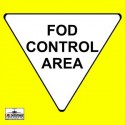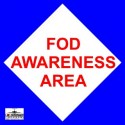by Bob Baron, Learjet Crews International, Inc.
It was only a few years ago that I realized just what FOD could do. It was a bit ironic actually. We flew a Learjet into a major overhaul facility where they proceeded to perform a complete overhaul on both General Electric CJ610 engines. After about 4 weeks, the aircraft was ready to be picked up with two “like new” engines. We did our cursory walkaround inspection and low and behold: a bunch of FOD damaged turbine blades on one of the engines!
 Unfortunately, the ramp where this facility had to do the run-ups was under construction and it was quite windy for a few days too. I noticed scaffolding and a bunch of construction crews very close to the ramp. You can probably figure out what happened. Fortunately, the aircraft was in just the right place to repair the damage.
Unfortunately, the ramp where this facility had to do the run-ups was under construction and it was quite windy for a few days too. I noticed scaffolding and a bunch of construction crews very close to the ramp. You can probably figure out what happened. Fortunately, the aircraft was in just the right place to repair the damage.
F.O.D., the acronym for Foreign Object Digestion, once known as Foreign Object Debris, is any kind of foreign object that can possibly enter an engine and cause large scale and costly damage. The damage can be so extensive that an entirely new engine may have to be installed.
FOD comes in many shapes and sizes. I have been to Fort Lauderdale Hollywood International Airport’s Operations Center and I have seen bags of collected FOD from just one day. At a major airport such as this one, ground crews routinely “sweep” the operations area searching for debris. Objects that I have seen include baggage tags, screws, bolts, nuts, rags, paper cups, napkins, screwdrivers, and other hand tools.
 How do these items wind up on a taxiway or runway you ask? The answer can be simple and obvious, but it can also be a mystery. Carelessness is one reason. Many workers on an airport operations area are not always aware of the hazards that FOD can create. Maintenance people have been known to forget a wrench in the engine inlet. Pilots have been known to leave a hat or a coffee cup on the wing during a preflight inspection. I have seen airport “rampers” while hastily restocking the food and beverages on a 757, carelessly drop paper goods to the ground without even attempting to let somebody know! The mystery FOD is the hardest to detect. This is the type that can just fall off an aircraft in a moments notice and not be detected until it’s too late. A clear-cut example of this would be the Air France Concorde tragedy in July 2000. A previous departing aircraft had some parts fall off during the takeoff roll. The Concorde ran into those parts on ITS takeoff roll and caused catastrophic damage.
How do these items wind up on a taxiway or runway you ask? The answer can be simple and obvious, but it can also be a mystery. Carelessness is one reason. Many workers on an airport operations area are not always aware of the hazards that FOD can create. Maintenance people have been known to forget a wrench in the engine inlet. Pilots have been known to leave a hat or a coffee cup on the wing during a preflight inspection. I have seen airport “rampers” while hastily restocking the food and beverages on a 757, carelessly drop paper goods to the ground without even attempting to let somebody know! The mystery FOD is the hardest to detect. This is the type that can just fall off an aircraft in a moments notice and not be detected until it’s too late. A clear-cut example of this would be the Air France Concorde tragedy in July 2000. A previous departing aircraft had some parts fall off during the takeoff roll. The Concorde ran into those parts on ITS takeoff roll and caused catastrophic damage.
 The last type of FOD I wanted to mention comes from Mother Nature. Birds have been a longstanding and controversial problem at many airports. When a bird is ingested in an engine, the outcome can be disastrous. A small bird may just harmlessly pass through the engine without any damage, but a larger bird may completely disintegrate internal components, causing total engine failure. Bird and wildlife mitigation has been a controversial issue with animal rights activists. But overall, effective and humane measures have been implemented and have met with a fair amount of success.
The last type of FOD I wanted to mention comes from Mother Nature. Birds have been a longstanding and controversial problem at many airports. When a bird is ingested in an engine, the outcome can be disastrous. A small bird may just harmlessly pass through the engine without any damage, but a larger bird may completely disintegrate internal components, causing total engine failure. Bird and wildlife mitigation has been a controversial issue with animal rights activists. But overall, effective and humane measures have been implemented and have met with a fair amount of success.
 So what can be done? FOD control begins with education and awareness. Any business operating on an airport should be made aware of what FOD damage can do in terms of safety and in terms of the millions of dollars worth of damage it causes every year. Posters, videos, leaflet, and flyers are a good start. A short class offered to airport businesses and employees would be even better!
So what can be done? FOD control begins with education and awareness. Any business operating on an airport should be made aware of what FOD damage can do in terms of safety and in terms of the millions of dollars worth of damage it causes every year. Posters, videos, leaflet, and flyers are a good start. A short class offered to airport businesses and employees would be even better!
Keep your eye out for FOD. Any time you are on a ramp, scan the area. If something is on the ground that shouldn’t be there, pick it up. If you are a pilot or a mechanic, be extra careful not to leave anything lying around.
FOD cannot be completely eliminated, but if we all pull together and do our part, we can minimize the safety hazards and financial burden that we all have to pay for sooner or later!
Author Bio
Robert Baron is the president and chief consultant of AviationCRM.com, a worldwide aviation safety consulting firm that specializes in Crew Resource Management and Human Factors Training for aviation departments. Mr. Baron also owns and operates Learjet Crews International, Inc. He holds an Airline Transport Pilot Rating and has over 15 years of aviation experience as a Line Captain, Instructor and Check Airman in Learjet aircraft. He’s also type-rated in the Cessna Citation and holds a Flight Engineer Rating for Turbojet aircraft. His academic achievements include a Bachelor’s Degree in Professional Aeronautics/Aviation Safety and a Masters Degree in Aeronautical Science with specializations in Aviation Safety/Human Factors from Embry-Riddle Aeronautical University. If you have any questions or would like additional information on CRM/Human Factors training, please don’t hesitate to contact Robert through e-mail or via phone at 954-803-5807.



